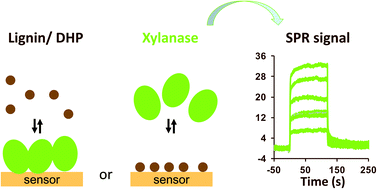Novel surface-based methodologies for investigating GH11 xylanase–lignin derivative interactions
Abstract
The recalcitrance of lignocellulose to bioprocessing represents the core problem and remains the limiting factor in creating an economy based on lignocellulosic ethanol production. Lignin is responsible for unproductive interactions with enzymes, and understanding how lignin impairs the susceptibility of biomass to enzymatic hydrolysis represents a significant aim in optimising the biological deconstruction of lignocellulose. The objective of this study was to develop methodologies based on surface plasmon resonance (SPR), which provide novel insights into the interactions between xylanase (Tx-xyn11) and phenolic compounds or lignin oligomers. In a first approach, Tx-xyn11 was fixed onto sensor surfaces, and phenolic molecules were applied in the liquid phase. The results demonstrated weak affinity and over-stoichiometric binding, as several phenolic molecules bound to each xylanase molecule. This approach, requiring the use of soluble molecules in the liquid phase, is not applicable to insoluble lignin oligomers, such as the dehydrogenation polymer (DHP). An alternative approach was developed in which a lignin oligomer was fixed onto a sensor surface. Due to their hydrophobic properties, the preparation of stable lignin layers on the sensor surfaces represented a considerable challenge. Among the various chemical and physico-chemical approaches assayed, two approaches (physisorption via the Langmuir–Blodgett technique onto self-assembled monolayer (SAM)-modified gold and covalent coupling to a carboxylated dextran matrix) led to stable lignin layers, which allowed the study of its interactions with Tx-xyn11 in the liquid phase. Our results indicated the presence of weak and non-specific interactions between Tx-xyn11 and DHP.


 Please wait while we load your content...
Please wait while we load your content...